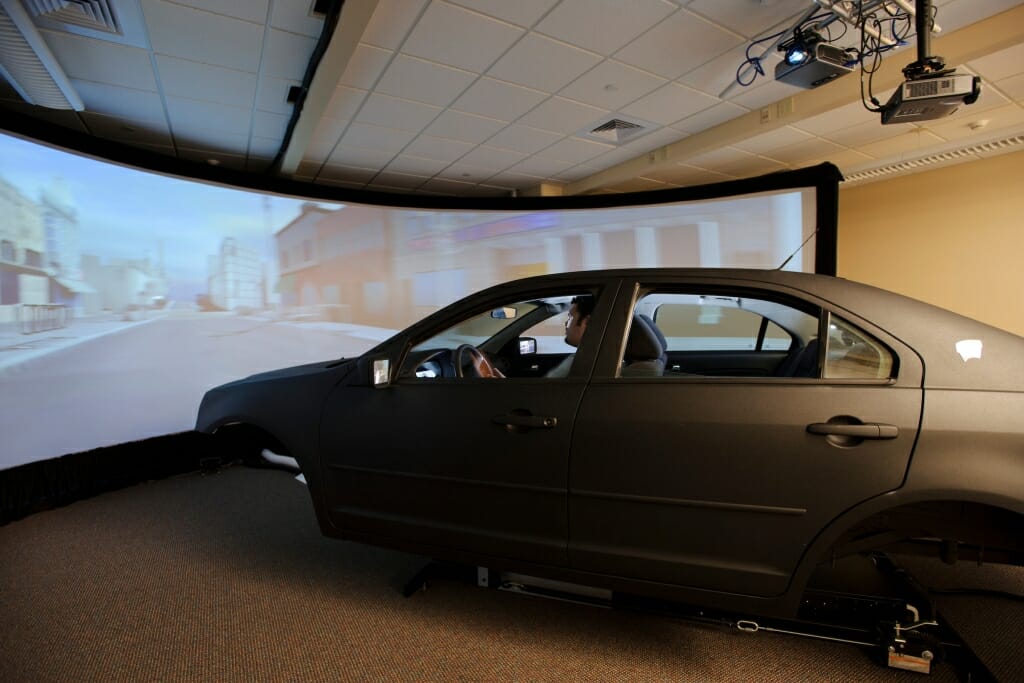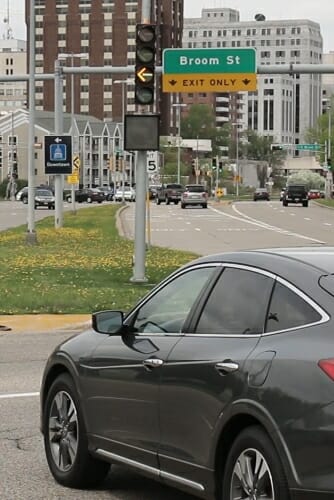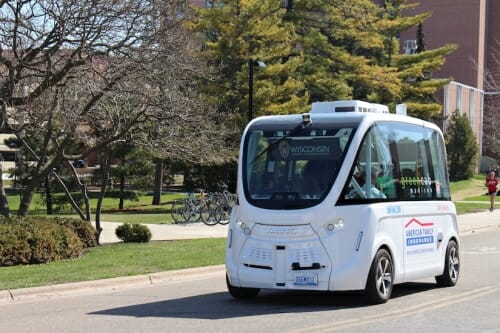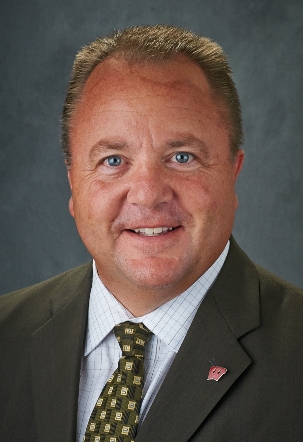The brains behind the traffic: 4 questions for mobility maven

A research assistant takes a behind-the-wheel virtual drive in UW–Madison’s Driving Simulation Laboratory. The lab includes 270 degrees of virtual reality, thanks to a 24-foot wraparound screen with computer video projection, audio and car-tracking movements. Photo: Jeff Miller
David Noyce, professor of transportation engineering at the University of Wisconsin–Madison, directs the Traffic Operations and Safety Laboratory, home of the Wisconsin Driving Simulator. With a focus on “human factors,” Noyce is at the forefront of efforts to streamline highway and vehicle infrastructure for greater safety and efficiency.
“Data suggests 90-plus percent of crashes result from some form of human error, so everything in transportation engineering at UW–Madison involves some aspect of understanding the driver before we attempt to change the system,” Noyce says.
In recent years, he’s become enmeshed in the effort to engineer self-driving (“autonomous”) vehicles. But you don’t have to visit the future to see the impact of traffic engineering — the evidence appears today on just about any roadway.
Noyce comments on four current traffic topics: yellow arrows, roundabouts, smarter highway signage, and autonomous vehicle safety.
Q: Why am I seeing flashing yellow arrows at left turns?
David Noyce: Left-turn crashes were a significant problem, especially for older drivers. Conventional left-turn signals were confusing: A circular green means go straight, so, logically, it also meant go left unless the left turn was controlled by a red or green arrow. It’s confusing to have a signal’s meaning differ depending on the driver’s intention.
After discussions around the country, and tests in driving simulators like ours, we started testing the flashing yellow arrow in the late 1990s to mean “yield and wait for a gap in opposing traffic.” Even if people are initially unsure of the meaning of a flashing yellow arrow, at worst, their response is, “I don’t know what it means. I’m going to stop, yield and figure it out.”

A left-turning driver does the right thing at a flashing yellow arrow light on John Nolen Drive in downtown Madison. Photo: David Tenenbaum
These arrows appear nationwide, and although we will never know how many injuries and fatalities they have prevented, I know it is some and think it is a lot. So much engineering and research went into this comparatively simple change, but most drivers don’t realize that.
Q: I’m seeing roundabouts all over the state. Why?
Noyce: Roundabouts improve safety and traffic flow. We at UW–Madison have been very active in research on them, but the basic safety improvement is rooted in simple physics. Roundabouts drastically reduce right-angle collisions, and nearly eliminate head-on collisions, which are the most dangerous types.
There are some new roundabouts where crash numbers have risen, but every study shows an elimination or significant reduction in fatalities and serious injuries because the roundabout takes out the probability of dangerous crashes. When traffic is congested, you have instances of a rear-end crash, or a sideswipe when merging. Those crashes may cosmetically damage the vehicles, but from a traffic engineering standpoint, I will take these crash types any day compared to a head-on or a 90-degree collision.
There is also a reduction in signals and signage, in electricity needed for signals, and an improvement in traffic flow. I don’t hear anybody complaining about not having to stop at the red light replaced by the roundabout, and studies show that more vehicles can flow through a particular intersection. Many of the objections fade as people learn what to expect at a roundabout.
Q: What role did the Traffic Operations and Safety Laboratory play in designing the Zoo Interchange in Milwaukee?
Noyce: We are the proud operators of one of the only full-scale driving simulators in the country, and one of our biggest design-related efforts concerned the reconstruction of Milwaukee’s Zoo Interchange that’s now being finished. We simulated a large segment of the interchange to scale and invited the Wisconsin Department of Transportation and the consulting design team to the lab to “drive” the segment, so we could look at it together and adjust and relocate design features, include signs, as needed. We found that some sign placements were not completely intuitive to the driver, allowed too little reaction time, or would be occluded by pillars at the edge of the vehicle windshield.
Normally these factors are not discovered until you have built the highway, and moving sign structures costs hundreds of thousands of dollars. For very little money — free, to some degree — we proved that you can fix key issues during design, using a lab-based simulator.
The multi-year reconstruction of Milwaukee’s Zoo Interchange involved a signage puzzle. By envisioning placement before the signs were erected, the UW–Madison Traffic Operations and Safety Laboratory (TOPS) was able to save money for the state. SOURCE: Wisconsin Department of Transportation 2014 animation via YouTube
Q: What did you make of the fatal crash involving an Uber autonomous vehicle in Tempe, Arizona?
Noyce: There were actually two failures: the vehicle failed to detect a woman walking her bike into the roadway, and the human attendant was apparently looking down, likely at a cellphone, and failed to manually override the vehicle and hit the brake.
Tempe prompted a broader discussion of why the autonomous vehicle did not react, and AVs were temporarily pulled off the public streets to evaluate and presumably fix the sensor system. But if indeed the human driver was distracted by a phone, it also highlights the general problem of people texting or surfing when they should be driving, and the challenge with the need to transfer from automated to manual control of automated vehicles during their implementation state of deployment.

The Autonom Shuttle, an 11-seat autonomous vehicle made by the French company Navya, took passengers a tour of UW–Madison campus streets in April 2018. Photo: Renee Meiller
Improved technology can help. Theory tells us, and initial testing confirms, that fully autonomous vehicles will never be foolproof; they won’t reduce the 40,000-per-year transportation fatality number to zero, but studies indicate they could reduce it by 75 to 80 percent, perhaps even greater, which obviously would be highly significant.
The Tempe Uber crash was terrible, but on the same day, numerous pedestrian fatalities and approximately 100 driver/passenger fatalities received no attention. If they did, that would likely move public opinion to solve some of today’s pressing safety issues, like distracted driving.
The College of Engineering at UW–Madison is active on a broad range of issues related to autonomous vehicles. To take one example, we lead a project that is placing communications devices on a major street corridor in Madison, with the objective of testing the communications between vehicles and traffic controls that autonomous vehicles will need.
Tags: engineering, technology, transportation

